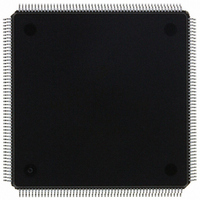MCF5307AI90B Freescale Semiconductor, MCF5307AI90B Datasheet - Page 146

MCF5307AI90B
Manufacturer Part Number
MCF5307AI90B
Description
IC MPU 32BIT COLDF 90MHZ 208FQFP
Manufacturer
Freescale Semiconductor
Series
MCF530xr
Datasheets
1.MCF5307AI66B.pdf
(484 pages)
2.MCF5307AI66B.pdf
(16 pages)
3.MCF5307AI66B.pdf
(2 pages)
Specifications of MCF5307AI90B
Core Processor
Coldfire V3
Core Size
32-Bit
Speed
90MHz
Connectivity
EBI/EMI, I²C, UART/USART
Peripherals
DMA, POR, WDT
Number Of I /o
16
Program Memory Type
ROMless
Ram Size
4K x 8
Voltage - Supply (vcc/vdd)
3 V ~ 3.6 V
Oscillator Type
External
Operating Temperature
0°C ~ 70°C
Package / Case
208-FQFP
Maximum Clock Frequency
90 MHz
Maximum Operating Temperature
+ 105 C
Mounting Style
SMD/SMT
Minimum Operating Temperature
0 C
Family Name
MCF5xxx
Device Core
ColdFire
Device Core Size
32b
Frequency (max)
90MHz
Instruction Set Architecture
RISC
Supply Voltage 1 (typ)
3.3V
Operating Temp Range
0C to 70C
Operating Temperature Classification
Commercial
Mounting
Surface Mount
Pin Count
208
Package Type
FQFP
Program Memory Size
8KB
Cpu Speed
90MHz
Embedded Interface Type
I2C, UART
Digital Ic Case Style
FQFP
No. Of Pins
208
Supply Voltage Range
3V To 3.6V
Rohs Compliant
Yes
Lead Free Status / RoHS Status
Lead free / RoHS Compliant
Eeprom Size
-
Program Memory Size
-
Data Converters
-
Lead Free Status / Rohs Status
Lead free / RoHS Compliant
Available stocks
Company
Part Number
Manufacturer
Quantity
Price
Company:
Part Number:
MCF5307AI90B
Manufacturer:
FREESCAL
Quantity:
153
Company:
Part Number:
MCF5307AI90B
Manufacturer:
Freescale Semiconductor
Quantity:
10 000
Part Number:
MCF5307AI90B
Manufacturer:
FREESCALE
Quantity:
20 000
- Current page: 146 of 484
- Download datasheet (6Mb)
Background Debug Mode (BDM)
DSI must meet the required input setup and hold timings and the DSO is specified as a delay
relative to the rising edge of the processor clock. See Table 5-1. The development system
serves as the serial communication channel master and must generate DSCLK.
The serial channel operates at a frequency from DC to 1/5 of the processor frequency. The
channel uses full-duplex mode, where data is sent and received simultaneously by both
master and slave devices. The transmission consists of 17-bit packets composed of a
status/control bit and a 16-bit data word. As shown in Figure 5-13, all state transitions are
enabled on a rising edge of the processor clock when DSCLK is high; that is, DSI is
sampled and DSO is driven.
DSCLK and DSI are synchronized inputs. DSCLK acts as a pseudo clock enable and is
sampled on the rising edge of the processor CLK as well as the DSI. DSO is delayed from
the DSCLK-enabled CLK rising edge (registered after a BDM state machine state change).
All events in the debug module’s serial state machine are based on the processor clock
rising edge. DSCLK must also be sampled low (on a positive edge of CLK) between each
bit exchange. The MSB is transferred first. Because DSO changes state based on an
internally-recognized rising edge of DSCLK, DSDO cannot be used to indicate the start of
a serial transfer. The development system must count clock cycles in a given transfer.
C1–C4 are described as follows:
5-18
• C1—First synchronization cycle for DSI (DSCLK is high).
• C2—Second synchronization cycle for DSI (DSCLK is high).
• C3—BDM state machine changes state depending upon DSI and whether the entire
• C4—DSO changes to next value.
BDM State
CPU CLK
PSTCLK
input data transfer has been transmitted.
Machine
DSCLK
DSO
DSI
A not-ready response can be ignored except during a
memory-referencing cycle. Otherwise, the debug module can
accept a new serial transfer after 32 processor clock periods.
Figure 5-13. BDM Serial Interface Timing
Freescale Semiconductor, Inc.
For More Information On This Product,
Current State
Past
Go to: www.freescale.com
C1
Current
MCF5307 User’s Manual
C2
NOTE:
C3
C4
Next State
Current
Next
Related parts for MCF5307AI90B
Image
Part Number
Description
Manufacturer
Datasheet
Request
R
Part Number:
Description:
Manufacturer:
Freescale Semiconductor, Inc
Datasheet:
Part Number:
Description:
Mcf5307 Coldfire Integrated Microprocessor User
Manufacturer:
Freescale Semiconductor, Inc
Datasheet:
Part Number:
Description:
Manufacturer:
Freescale Semiconductor, Inc
Datasheet:
Part Number:
Description:
Manufacturer:
Freescale Semiconductor, Inc
Datasheet:
Part Number:
Description:
Manufacturer:
Freescale Semiconductor, Inc
Datasheet:
Part Number:
Description:
Manufacturer:
Freescale Semiconductor, Inc
Datasheet:
Part Number:
Description:
Manufacturer:
Freescale Semiconductor, Inc
Datasheet:
Part Number:
Description:
Manufacturer:
Freescale Semiconductor, Inc
Datasheet:
Part Number:
Description:
Manufacturer:
Freescale Semiconductor, Inc
Datasheet:
Part Number:
Description:
Manufacturer:
Freescale Semiconductor, Inc
Datasheet:
Part Number:
Description:
Manufacturer:
Freescale Semiconductor, Inc
Datasheet:
Part Number:
Description:
Manufacturer:
Freescale Semiconductor, Inc
Datasheet:
Part Number:
Description:
Manufacturer:
Freescale Semiconductor, Inc
Datasheet:
Part Number:
Description:
Manufacturer:
Freescale Semiconductor, Inc
Datasheet:
Part Number:
Description:
Manufacturer:
Freescale Semiconductor, Inc
Datasheet:











